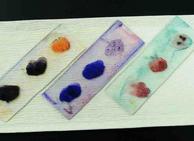 | ||||
Differential Staining & Bacterial Controls
Positive & Negative Controls: Gram, Acid-fast & Endospore Stains
LAB NOTES from Science Prof Online
There are many staining techniques that can be used to view bacteria. Simple stains employ only one dye, and provide information limited to cell shape and grouping. The use of differential stains is more complex. Differential protocols employ a series of dyes to distinguish different types of bacteria based on some chemical or structural attribute of the cell.
Article Summary: Bacterial controls are often used with differential stains as examples of typical positive and negative stain reactions; a helpful reference when identifying unknowns.
Differential Staining & Bacterial Controls
Page last updated
5/2014
 | ||||
You have free access to a large collection of materials used in a college-level introductory microbiology course. The Virtual Microbiology Classroom provides a wide range of free educational resources including PowerPoint Lectures, Study Guides, Review Questions and Practice Test Questions.
Left to Right: Gram, Acid-fast & Endospore-stained slides of bacterial smears with positive controls on either end of slide and unknown in center.
SPO VIRTUAL CLASSROOMS
 | ||||||
 | ||||||
SPO is a FREE science education website. Donations are key in helping us provide this resource with fewer ads.
Please help!
(This donation link uses PayPal on a secure connection.)
SPO Video: How to Prepare a Bacterial Smear for Gram Staining
Go to > Gram stain video
A negative control would be any known Gram- organism, such as Esherichia coli.
Acid Fast Stain Controls
The Acid-fast stain is specifically used to identify bacteria that possess a waxy lipid within the structure of their cell walls, mycolic acid. Due to the presence of this lipid, water-based stains, such as the Gram stain, do not work well on Acid-fast organisms. This protocol utilizes heat to drive the primary stain into waxy bacterial cell walls.
Gram Stain Controls
The Gram stain classifies nearly all bacteria into one of two groups (Gram+ or Gram-), based on characteristics of the bacterial cell wall, specifically the location and amount of the cell wall's primary structural molecule, peptidoglycan.
Bacteria that have cell walls entirely made of peptidoglycan will stain Gram-positive. When preparing a Gram stain slide, a positive control would be a type of bacterium that is known to stain Gram+, such as Staphylococcus.
SCIENCE VIDEOS
Differential stains are often used for general identification of bacteria, rather than identifying the exact species. Examples include the Gram stain, Acid-fast stain and Endospore staining protocols.
Bacterial Controls
When doing a differential stain, it is best to use controls to help identify the stain reaction of the unknown bacteria. Controls are types of bacteria that are known to show a certain, specific stain reaction.
Very few types of bacteria can form endospores; most notably Bacillus and Clostridium. So a positive control for the Endospore stain would be a bacterium that produces endospores; a negative control would be any type of bacteria that are not endospore producers.
SPO Video: How to Prepare a Bacterial Smear for Acid Fast Stain
Go to > Acid-fast stain video
Endospore Stain Controls
The Endospore stain is used to identify bacteria that can produce tough, dormant spores. Endospores enable bacteria to withstand many hardships, such as excessive heat, lack of nutrients, and some bacteriocidal chemicals.
Sources & Resources
- Schauer Cynthia (2007) Lab Manual to Microbiology for the Health Sciences, Kalamazoo Valley Community College.
How to Prepare a Bacterial Smear for Endospore Staining
Go to > Endospore stain video
- Bauman, R. (2014) Microbiology with Diseases by Body System, 4th ed., Pearson Benjamin Cummings.
- Videos of Preparing Bacterial Smears: Gram Stain, Acid-fast Stain & Endospore Stain
- How to Use a Compound Light Microscope, SPO Class Notes Article (Video)
- Viewing Bacteria Under Oil Immersion, SPO Class Notes Article
When doing an Acid-fast stain, the positive control would be an acid-fast bacterium with the characteristic waxy cell wall, such as members of the genera Mycobaterium or Nocardia. Most bacteria do not possess these special waxy lipids, so a nonacid-fast organism would be any bacterium other than Mycobacterium
and Nocardia.





